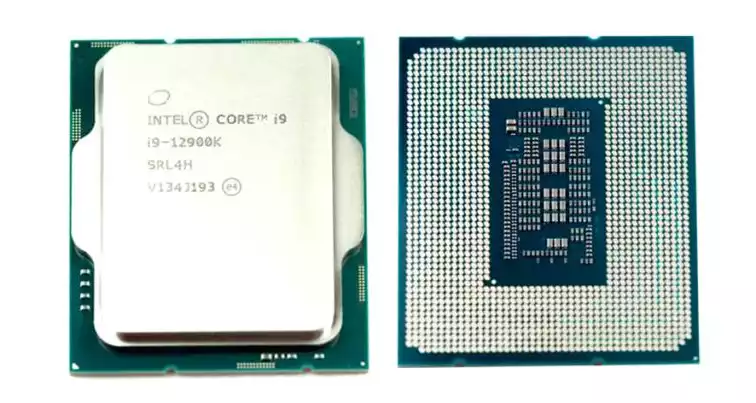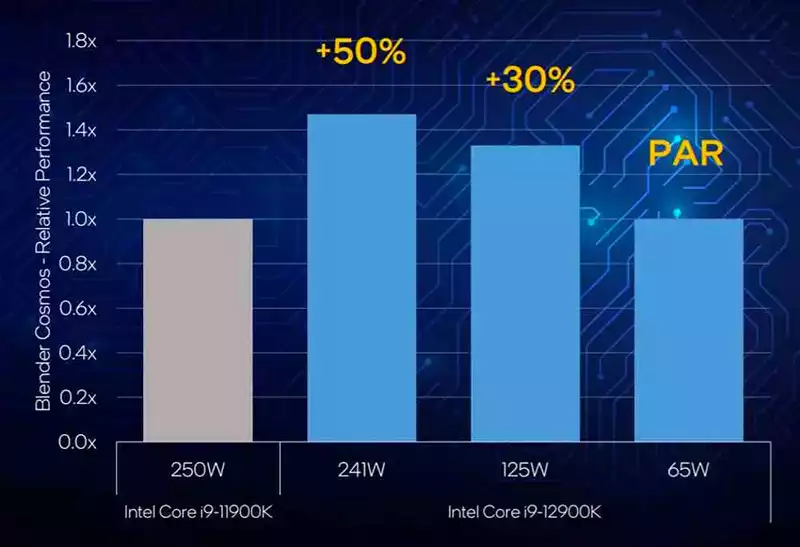You can also be interested in these:
- Comparison of the Z790 and Z690 Intel motherboard chipsets
- Who leads the battle of the CPUs in 2023?
- Intel NUC 13 Extreme Mini ITX barebone full review
- Intel B760 vs B660 chipset: Features and differences
History has taught us that the most significant advances in the architecture of computer processors only occur when the previous scheme is redefined from scratch without prejudice, as we saw with AMD’s Zen architecture, which we have seen evolve in three different generations and on its way to the fourth. As for Intel, the last big change we witnessed was when they went from the Netburst architecture of the Pentium IV to Conroe in the first Intel Core models, and around a decade before that with the appearance of the Pentium Pro.

As for the Intel Core i9-12900K Alder Lake CPU, we are not seeing just a component upgrade, a simple renewal of the range of processors, it is not a matter of adding a number to the series. The changes Intel are introducing with this new processor are much more profound and meaningful, promising the Alder Lake-S architecture 12 will become the basis of the Intel CPU architecture for the next five years.
Not considering the appearance of Lakefield, this would be the first time Intel has relied its main flagship processors on the use of two types of cores with different performance and consumption to accelerate the computer processing tasks:

- P-Cores are large cores that offer great performance, but at the cost of being less energy efficient.
- E-Cores are smaller cores, allowing Intel to fit more in the same space and have lower power consumption.
Depending on the Intel Core 12 model, the number of P-Cores and E-Cores varies, however both will work in unison and in a coordinated manner. Precisely for simultaneous interactions they make use of a 30 MB cache, which gives them access to the same memory space, despite being different types of cores. It also allows them to work together in the execution of the processes.
How does the Intel Core i9-12900K Alder Lake CPU work?
To understand what is intended to be achieved with the design of the Intel Core 12 we must bear in mind that every program execution is divided into two parts:
- A part that runs in series, on a single processor and therefore it will need to be as fast as possible to accelerate its execution, so this part of the programs in the Intel Core 12 is handled by the P-Cores.
- The other part that can be run in parallel, so adding more processors will speed up the resolution of the same. E-Cores oversee this type of tasks.

On a PC there are more tasks than meet the eye and their correct assignment is important, for instance, there may be the case that while you are playing a video game the email client application is updating the inbox. Gaming is a foreground process and email management is a background process, so it’s best to assign those secondary tasks to a less powerful processor. The processes on the background will still be achieved, but it won’t represent a detriment on the scope of the processing power.
P-Cores vs. E-Cores in mono-thread

The P-Cores, are high-performance cores, their L2 cache is local to each processor, whereas the E-Cores have this level shared between several cores. The first two cache levels are not shared between both types of cores (As we already mentioned the third level is the one shared among them).
At the end of the day the only metric we care about is the performance, and at the same clock speed the P-Cores obtain 28% additional performance compared to the tenth generation of Intel Core processors, while the E-Cores are 1% above with respect to the same generation. The E-Cores are not power-worthy cores, their single-wire performance is at the level of the Comet Lake.
The E-Cores in the Intel Core i9-12900K Alder Lake are designed with a high energy efficiency in mind, they not only work at a lower clock speed, but also don’t have support for HyperThreading.
PL1 and PL2: Performance per Watt
One way to measure the energy efficiency in a processor compared to another is to see how many watts they consume to perform the same task. In the case of the Intel Core 12 we have two consumption profiles, in the so-called PL1 the processor consumption is set at 125 W, while in PL2 it is at 241 W.
Now, both power metrics combine to result in an overall power consumption of up to 241 watts for higher-end CPUs, a lower figure than its predecessor.
According to Intel, if the Core i9-12900K is compared with the i9-11900K, the first one obtains with only 65 W the same performance as the latter with a consumption four times higher (260 W). This is a leap in efficiency that we did not see since the change from the Pentium IV to the Core 2. Already in PL1 mode the new Intel Alder Lake processor achieves 30% more performance than the previous generation with less than half the consumption, already almost equal TDP (heat generation), an additional 50%.
The increase in efficiency comes from two different ways, on one hand by the use of a new manufacturing node that always favours advantages in consumption and clock speed, the secondly by the use of an hybrid architecture.
Performance in games and applications
Intel announced metric reports and benchmarks about the performance of the Intel Core i9-12900K compared to its direct rival, the Ryzen 9 5950X in several different types of applications. Starting with video games we can see an increase that goes from 3% in the case of Shadow of the Tomb Raider to 30% in Troy: Total War Saga.

Also adding to the mix creative production applications, the comparison that the blue team created compared the i9-12900K and the i9-11900K. Here you can see how in the PugetBench under Premiere Pro reaches an additional 32%, but in After Effects it manages to double performance.

Intel Thread Director
The control unit is the most important part of a CPU, after all, it is in charge of two of the stages of the instruction cycle: capturing data and decoding the instructions. The latter includes the appropriate assignment to the units of execution.
In a hybrid system like the Intel i9-12900K Alder Lake, it is also important where the assignment of each process go to run as efficiently as possible. That is why Intel has added a new function to the Intel Core 12 control unit, which measures the execution time of each process to be performed and recommends the operating system, where it is better to execute, if in the P-Cores or the E-Cores.
It not only cuts a chunk of the time cost of each instruction, it also cuts the energy cost. Not all instructions consume the same amount of energy. The objective of this new functionality is that a process requiring high performance does not go to the E-Cores, which would lead to a slower execution, or that a light process does not go to the P-Cores, it would result in a big waste of efficiency.
The Intel Core 12 processor lineup
The initial range of Intel Core 12 is divided into six different CPUs, three configurations with two variants, with and without an integrated GPU. For both the Intel Core i5-12600K and Intel Core i5-12600KF variants, the overclocking functions of the Intel Turbo Boost Max 3.0 have been disabled.
Overclocking

A very important element of a processor is the ability to vary its clock speed and since it is the first CPU under the Intel 7 node there have also been improvements at the manufacturing level that allow it to achieve high clock speeds with a lower consumption compared to previous generations of Intel processors, especially on the desktop where this node is used for the first time.
The overclocking system of the Intel Core 12 allows the following changes to be made to both the P-Cores and the E-Cores:
- Ability to enable and disable the execution of AVX instructions.
- HyperThreading can be disabled in the P-Cores if necessary in pursuit of achieving a lot more execution speed.
- You can adjust the voltage at the individual level of each core: We can lower the clock speed for some to increase it on others.
- We have advanced options for overclocking that allow us to vary values such as TjMax, PLL and BCLK.
- Ability to connect and disconnect cores individually and separately from the rest.
Support for DDR5 and XMP 3.0 memory
The Intel Core 12 is the first processor for PCs on the market supporting DDR5 memory. Moreover, they support DDR5-4800 modules, although they are compatible with faster memories. For this, the processor memory controller is set to half speed to match the signal times, so the DDR5 type RAM memory will make Alder Lake processors work best, being the DDR5-4800 type the most recommended in terms of latency time of the instructions.

The Alder Lake-S architecture inherits all the capabilities of its predecessors with respect to DDR4 memory, to which it is also compatible, and moves it to the new standard by creating version 3.0 with memory overclocking. DDR5 technology controls the voltage on each memory module, which has forced Intel to develop XMP 3.0. With this, the number of profiles available for Intel Core 12 has gone from 2 to 5.
I/O on Intel Core 12 and the Z690 chipset
Nowadays, all CPUs have a series of I/O interfaces built into them. Intel Core i9-12900K processors implements a new PCI Express 5.0 technology that doubles in bandwidth with respects to version 4.0. The new processor integrates 16 lines, so it is ready for the new generation of gaming graphics cards to be released in 2022 making use of this standard.
Intel Core i9-12900K Alder Lake has a LGA1700 socket, with a Z690 chipset. The communication done with the DMI 4.0 interface, helps in doubling the bandwidth between the CPU and its Southbridge. The I/O interfaces provided by the Z690 chipset to the Intel Core 12 are the following:
- Integrated WiFi 6E (Gig +) radio.
- Adds 12 PCI Express 4.0 lanes and 16 having 3.0 speed.
- Regarding USB connectivity, it supports standard version 3.2 with the following configurations:
- 4 2 x 2 ports
- 10 2 × 1 ports
- 10 1 × 1 ports.
- Support for up to 14 USB 2.0 ports.
- 8 SATA-III lines.
The chipset also incorporates other Intel technologies such as Platform Trust Technology, essential for running Windows 11, and also support Rapid Storage and Optane technologies.
More stories like this
- Comparison of the Z790 and Z690 Intel motherboard chipsets
- Who leads the battle of the CPUs in 2023?
- Intel NUC 13 Extreme Mini ITX barebone full review
- Intel B760 vs B660 chipset: Features and differences
- Which Intel CPU works best with liquid cooling?
- Seemingly all Intel Alder Lake CPU can be overclocked after all